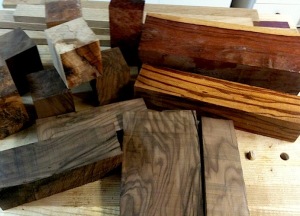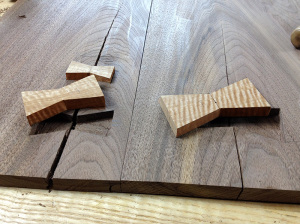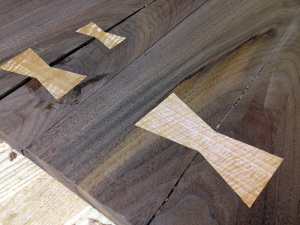Learn About The Wood We Work
 Clockwise from upper left: Walnut, Maple, Amboyna, Grenadillo, Marblewood, and Walnut[/caption]As woodworkers we are blessed with an overwhelmingly diverse and beautiful palette of woods to work. Pick a color or texture and there is a wood somewhere in the world that will scratch that itch. I have been lucky to have an opportunity to work with many different species from 6 continents. Most of the really unusual stuff has been in small quantities on my lathe making a pen, box, or bowl. Woodturning is a great place to explore new species since you can use very little wood in your project and often these really exotic species are available in turning square sized blanks. If you enjoy working with it and aren’t turned off by an odd smell or allergic reaction then maybe you can incorporate it into your next furniture project or flat work build. At the same time, if you are anything like me, you get a valuable education. I like to know more about the woods that I work and anytime I’m confronted with a new species, I research its origin and physical properties. Most of the time, this information gets stored in that database in my head titled “useless facts for starting (and ending) conversations at parties”. Shouting “Fraxinus excelsior” at a party can get you out of awkward conversations and it doubles as a super hero catch phrase!
Clockwise from upper left: Walnut, Maple, Amboyna, Grenadillo, Marblewood, and Walnut[/caption]As woodworkers we are blessed with an overwhelmingly diverse and beautiful palette of woods to work. Pick a color or texture and there is a wood somewhere in the world that will scratch that itch. I have been lucky to have an opportunity to work with many different species from 6 continents. Most of the really unusual stuff has been in small quantities on my lathe making a pen, box, or bowl. Woodturning is a great place to explore new species since you can use very little wood in your project and often these really exotic species are available in turning square sized blanks. If you enjoy working with it and aren’t turned off by an odd smell or allergic reaction then maybe you can incorporate it into your next furniture project or flat work build. At the same time, if you are anything like me, you get a valuable education. I like to know more about the woods that I work and anytime I’m confronted with a new species, I research its origin and physical properties. Most of the time, this information gets stored in that database in my head titled “useless facts for starting (and ending) conversations at parties”. Shouting “Fraxinus excelsior” at a party can get you out of awkward conversations and it doubles as a super hero catch phrase!
But sometimes wood knowledge can be pulled into service while at the bench. Understanding why a certain wood works the way it does can be really helpful when you comes across an unknown or new species. By examining the physical properties and divining the origin you can compare it with other similar species with which you have a working knowledge. Is the species ring or diffuse porous? What is the hardness or specific gravity? Knowing some of these values requires that you know what you are working with so you can look it up (unless you have the testing facility to run Janka tests or displacement). If the species is unknown then physical observation can go a long way to determining how this wood will work. How heavy is it? Is is open grained or closed (ring or diffuse porous)? Does the grain sparkles in the light (high mineral content)? How tightly packed, or not, are the growth rings? What figure is present and how visible are the medullary rays? There is more but I think you get the idea.
 This weekend I had 8 or 10 highly figured pieces of wood laid out on a table top trying to figure out which would be best to inlay as butterfly splines. Each looked good so just going with my aesthetic sense was only going to get me so far. Each species was heavily figured so I knew no matter what that hand planing it would be difficult. The one that kept catching my eye was a turning square of an unknown species. It was something I had bought more than 5 years ago on eBay to use for small turning projects but had since forgotten what it was. The color looks similar to White Oak but the closed pore structure said otherwise. A quick check of the end grain told me it is a diffuse porous wood (White Oak is ring porous) and the even distribution of growth rings and lack of early/late wood differentiation told me it is a tropical species. The weight of the blank was similar to some of the Hard Maple turning squares in my shop so I made a guess that the density and specific gravity would be similar. I could just make out the medullary rays and they were quite small, similar to Maple. I knew therefore that while hard the grain would work uniformly, but under sunlight small reflective bits of silica could be seen so I knew that I would probably need to resharpen during and after working it. I’m guessing I have a block of fiddleback Anigre as many of the characteristics match, but I’m ultimately not sure. The point is that is doesn’t really matter, and simple observation has helped me to glean how this unknown will work and I am prepared when I make that first saw cut and start to pare it.
This weekend I had 8 or 10 highly figured pieces of wood laid out on a table top trying to figure out which would be best to inlay as butterfly splines. Each looked good so just going with my aesthetic sense was only going to get me so far. Each species was heavily figured so I knew no matter what that hand planing it would be difficult. The one that kept catching my eye was a turning square of an unknown species. It was something I had bought more than 5 years ago on eBay to use for small turning projects but had since forgotten what it was. The color looks similar to White Oak but the closed pore structure said otherwise. A quick check of the end grain told me it is a diffuse porous wood (White Oak is ring porous) and the even distribution of growth rings and lack of early/late wood differentiation told me it is a tropical species. The weight of the blank was similar to some of the Hard Maple turning squares in my shop so I made a guess that the density and specific gravity would be similar. I could just make out the medullary rays and they were quite small, similar to Maple. I knew therefore that while hard the grain would work uniformly, but under sunlight small reflective bits of silica could be seen so I knew that I would probably need to resharpen during and after working it. I’m guessing I have a block of fiddleback Anigre as many of the characteristics match, but I’m ultimately not sure. The point is that is doesn’t really matter, and simple observation has helped me to glean how this unknown will work and I am prepared when I make that first saw cut and start to pare it.
 The worst thing is when you buy a bunch of wood because it looks cool and realize how difficult it is to work or that your body is reacting violently to the dust a quarter of the way into the project. Let’s be honest, with today’s tooling most any wood can be “tamed”, but the knowledge you gain from understanding why it works the way it does will serve you each time you enter the woodshop. Plus if you are selling your work, understanding where the species came from will add distinction and a back story to your piece. It also helps when the inevitable sustainability question arises from your potential customer.
The worst thing is when you buy a bunch of wood because it looks cool and realize how difficult it is to work or that your body is reacting violently to the dust a quarter of the way into the project. Let’s be honest, with today’s tooling most any wood can be “tamed”, but the knowledge you gain from understanding why it works the way it does will serve you each time you enter the woodshop. Plus if you are selling your work, understanding where the species came from will add distinction and a back story to your piece. It also helps when the inevitable sustainability question arises from your potential customer.
We can talk about techniques all days long, but the reality is that many woodworkers would benefit greatly just by spending time learning about the medium we work and observing why it works well or doesn’t work well. In the tough situations, this understanding will help you formulate a way to smooth it, pare it, or finish it. Wood is good, why not learn all you can about it?
Blatant Self Promotion Alert
By the way I did a wood species world tour lesson in Hand Tool School Semester 4 that goes into much greater detail on the 3 or 4 key properties to help you determine the workability of a wood species. I’m told by members that the lesson was “worth the price of the whole semester”. Ok end blatant self promotion.


